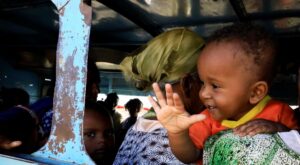-
Ethiopian refugee children at risk of exploitation, trafficking in Sudan

Dozens of children are still waiting to be reunited with their families after crossing into Sudan alone to flee conflict in Ethiopia’s Tigray region, aid agencies said, warning that they could be at risk of abuse, trafficking and child labor.
More than 58,000 Ethiopian refugees have crossed into Sudan - about a third of them children - since fighting erupted in the northern region in November between federal troops and the Tigray People’s Liberation Front (TPLF).
The UN refugee agency (UNHCR) said more than 100 unaccompanied minors had been reunited with their families since the beginning of the conflict, but roughly the same number were still on their own in Sudan at the end of last year.
“Children travelling alone with no protection from an adult are more exposed to exploitation, trafficking and different types of abuse,” said Vanessa Coeffe, senior child protection manager at the International Rescue Committee (IRC).
Aid workers said the additional movement of refugees from transit centers to camps in Sudan had complicated ongoing tracing efforts. Since early January, the UNHCR has moved thousands of refugees to the new Tunaydbah camp.
 An Ethiopian refugee who fled Tigray region holds a child inside a courtesy bus at the Fashaga camp, as they are transferred to Um-Rakoba camp on the Sudan-Ethiopia border, in Kassala state, Sudan. (Reuters)
An Ethiopian refugee who fled Tigray region holds a child inside a courtesy bus at the Fashaga camp, as they are transferred to Um-Rakoba camp on the Sudan-Ethiopia border, in Kassala state, Sudan. (Reuters)Bakary Sogoba, child protection specialist at the UN children’s agency (UNICEF) in Sudan, said the lack of access to Tigray - where some of the children’s relatives remain - could present a further challenge to family reunification work.
In the meantime, aid workers said it was crucial to look into alternative care options for children - some of them traumatized - whose parents could still not be found.
Living conditions in the camps can protract traumatic experiences, and gender-based violence and sexual exploitation are additional risks, said Anika Krstic, country director for Plan International Sudan.
“As responders, (we need) to make sure that there is prevention, that there is awareness and that there are ways of seeking recourse and assistance,” Krstic told the Thomson Reuters Foundation.
“We need to do more but all of the prevention measures that are usual in such emergency situations are being set up.”
 Ethiopians who fled the ongoing fighting in Tigray region, sit and lay in their makeshift shelter in the Hamdayet village, in eastern Kassala state, Sudan. (Reuters)
Ethiopians who fled the ongoing fighting in Tigray region, sit and lay in their makeshift shelter in the Hamdayet village, in eastern Kassala state, Sudan. (Reuters)Some unaccompanied and separated children have already been placed in foster care or communal centers, while child-friendly spaces and temporary learning centers have been set up in camps.
“A strong network of able social animators and social workers – when possible also within the same refugee community – is pivotal to keep the children safe from risks such as abuse or exploitation,” said Giulia Raffaelli, senior external relations officer at UNHCR in Sudan.
Still, the IRC voiced concern that the lack of services, education and safe areas for children in the new Tunaydbah camp had pushed some refugees into child labor.
Fighting is still going on in several parts of Tigray and almost 2.3 million people, or nearly half of the region’s population, need aid, a UN report said last week.
source: Reuters
Image source: Reuters
Levant
You May Also Like
Popular Posts
Caricature
BENEFIT Sponsors BuildHer...
- April 23, 2025
BENEFIT, the Kingdom’s innovator and leading company in Fintech and electronic financial transactions service, has sponsored the BuildHer CityHack 2025 Hackathon, a two-day event spearheaded by the College of Engineering and Technology at the Royal University for Women (RUW).
Aimed at secondary school students, the event brought together a distinguished group of academic professionals and technology experts to mentor and inspire young participants.
More than 100 high school students from across the Kingdom of Bahrain took part in the hackathon, which featured an intensive programme of training workshops and hands-on sessions. These activities were tailored to enhance participants’ critical thinking, collaborative problem-solving, and team-building capabilities, while also encouraging the development of practical and sustainable solutions to contemporary challenges using modern technological tools.
BENEFIT’s Chief Executive Mr. Abdulwahed AlJanahi, commented: “Our support for this educational hackathon reflects our long-term strategic vision to nurture the talents of emerging national youth and empower the next generation of accomplished female leaders in technology. By fostering creativity and innovation, we aim to contribute meaningfully to Bahrain’s comprehensive development goals and align with the aspirations outlined in the Kingdom’s Vision 2030—an ambition in which BENEFIT plays a central role.”
Professor Riyadh Yousif Hamzah, President of the Royal University for Women, commented: “This initiative reflects our commitment to advancing women in STEM fields. We're cultivating a generation of creative, solution-driven female leaders who will drive national development. Our partnership with BENEFIT exemplifies the powerful synergy between academia and private sector in supporting educational innovation.”
Hanan Abdulla Hasan, Senior Manager, PR & Communication at BENEFIT, said: “We are honoured to collaborate with RUW in supporting this remarkable technology-focused event. It highlights our commitment to social responsibility, and our ongoing efforts to enhance the digital and innovation capabilities of young Bahraini women and foster their ability to harness technological tools in the service of a smarter, more sustainable future.”
For his part, Dr. Humam ElAgha, Acting Dean of the College of Engineering and Technology at the University, said: “BuildHer CityHack 2025 embodies our hands-on approach to education. By tackling real-world problems through creative thinking and sustainable solutions, we're preparing women to thrive in the knowledge economy – a cornerstone of the University's vision.”
opinion
Report
ads
Newsletter
Subscribe to our mailing list to get the new updates!






















